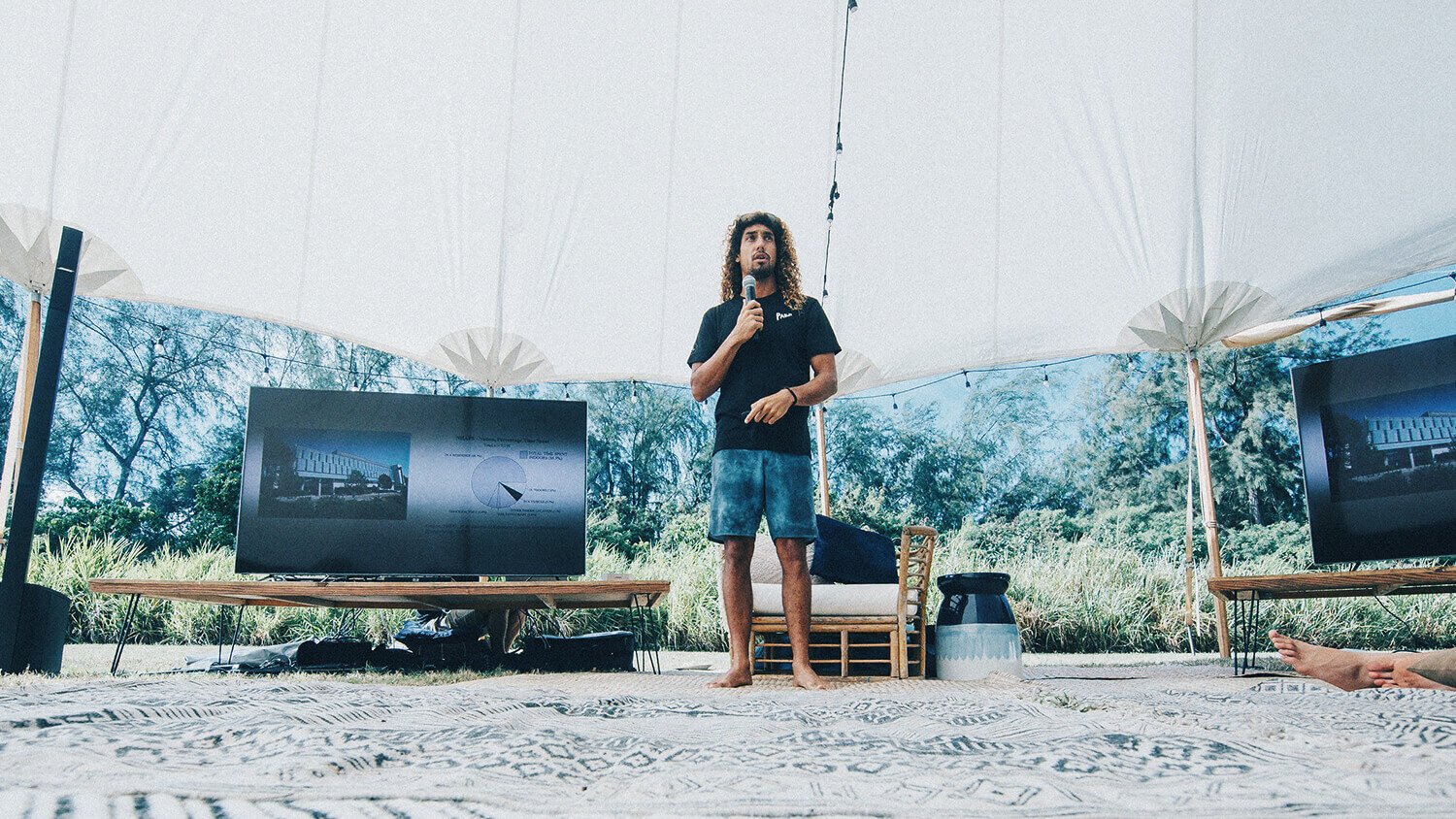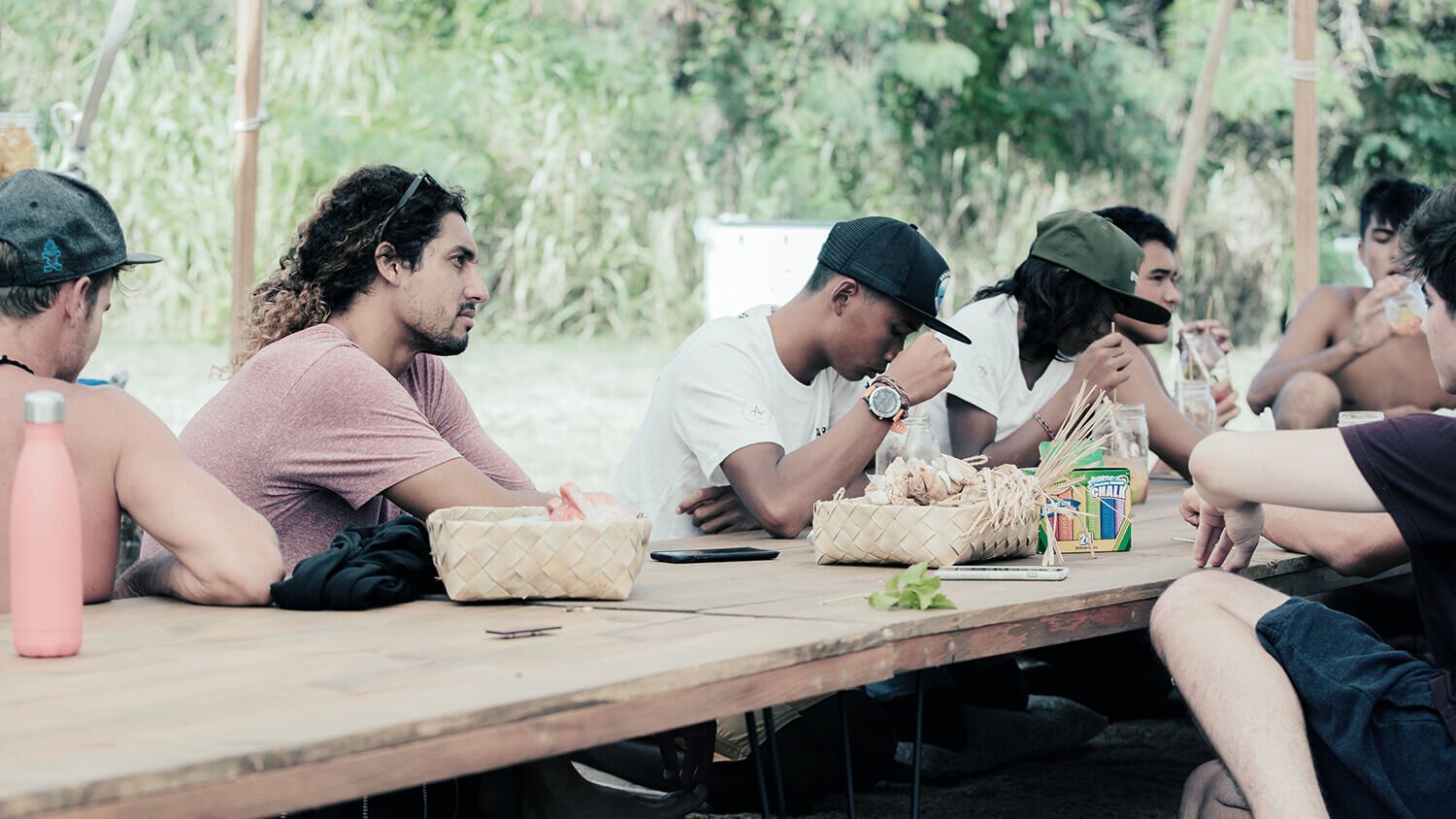The Network: Cliff Kapono
Surfer • Scientist • Storyteller • Activist
Born and raised on the eastern shores of Hawai’i, Parley collaborator Dr. Cliff Kapono, PhD, has learned at the water’s edge his entire life. Today he’s carving an unconventional path in the environmental movement, combining talents as a surfer, scientist, storyteller, filmmaker and activist in pursuit of environmental stewardship and justice.
As a surfer-scientist, Cliff divides his time between the waves and the lab, drawing connections that challenge perceived barriers between humans and nature, and land and sea. Cliff’s contributed to several peer-reviewed publications in the fields of molecular bioscience and produced award-winning films that discuss Indigenous activism, ocean conservation, global food security and virtual reality. Through projects spanning research, education, surfing and storytelling, he’s working to support eco-innovation and new ways of understanding and protecting marine ecosystems.
We are all connected to the oceans. Our hearts, brains and bodies are mostly water. We go about our lives breathing oxygen generated by the life in the seas, all the while forgetting our inextricable link to our origins. Cliff’s research explores how our very microbes connect us to the marine realm. Infusing science, creative storytelling and generations of ecological wisdom, he’s bringing to light the unseen ways humans change, and are changed by, the oceans.
Cliff’s work with the MEGA Lab based in Hilo, Hawai’i, explores coral health, focusing on innovative methods of monitoring reefs and interpreting the chemical and geophysical impacts affecting coral systems. He’s brought his work in 3D modeling and molecular profiling of coral communities to the atolls and reefs of the Maldives, where Parley is piloting a nationwide implementation of our AIR Strategy: Avoid. Intercept. Redesign.
As a doctoral student at UC San Diego, Cliff set out to study how immersion in the oceans alters gut bacteria and influences human health. Leading the Surfer Biome Project, he combined bioscience, wave-riding and technology to collect, sequence and map samples from hundreds of surfers around the world.
In his award-winning short film, Surf Wasted, Cliff examines ways surfers can minimize their impact on the environment. His latest series, the Cliff Notes, encourages a multidisciplinary approach to science and activism by highlighting the many unconventional ways we can work together to protect the planet.
"Many of us have forgotten our intimate connection to the ocean. Forgotten how by simply being in the sea alters our genetic diversity. I was taught that nature will always find a balance and if we listen closely, we too have a humble role to play. For me, wildness isn’t loud or aggressive. It’s about finding stillness. It’s about being in harmony with everything around us."
Cliff Kapono
What’s your earliest memory of the sea?
Cliff: I was with my dad. I remember desperately trying to hold onto his back while the white water of the wave splashed my face. I was so scared to fall off, but I also knew he wouldn't let that happen. We would do it over and over again laughing after each wave. Back then, surfing wasn't just about being in the ocean. It was about family.
How has being native Hawaiian shaped your worldview and approach to science and activism?
As kanaka maoli, I believe that we have an innate responsibility to our community and our environment. Now having friends and family scattered across the globe, I feel that same obligation to a lot more people and places outside of Hawai’i.
Surfboards and lab coats are an unconventional mix. What does it mean to be a surfer-scientist? How does one inform the other?
If you asked me five years ago to define a surfer-scientist I don't think I would have a good answer. Mostly because the type of surfer-scientist that I wanted to become didn't quite exist yet. I set out to demonstrate a high level of proficiency in the waves, but also have that same level of proficiency in the science research world. I feel that having a life that is equal parts surfing as it is science research, I can tap into a much richer side of living. Being able to experience nature in one of the rawest forms helps me stay committed when developing new technology to protect our planet.
When and how did you first become interested in biochemistry?
I was always intrigued by conventional science. I have what some may call a "wandering imagination." It is difficult for me to stay focused on any one thing for long periods of time. Chemistry doesn't necessarily keep me focused, but rather it adds fuel to my exploratory mind. Thinking about how molecules interact across the planet is incredibly inspiring. It fuels my creativity both in the lab and in the surf.
How did the Surfer Biome Project come to be and what were your findings? What does the microbiome of surfers tell us about the world?
The surfer biome project is a way to share that we humans are connected to nature on a molecular level. Having traveled across the world and shared time with many different societies, there is a considerably large number of individuals who feel that nature is tangential to their everyday lives. Providing evidence that our molecular composition is affected by the environments we frequent is a great way for people to form a more personal connection to the natural world. The Surfer Biome Project demonstrated that the ocean connects us on a molecular level even if we are on opposite parts of the globe.
Tell us about MegaLab - what are you focusing on now?
The Mega Lab is a research group founded by Professor John HR Burns in Hilo, Hawai’i. The mission of the Mega Lab is to find environmental solutions that are grounded in science, technology and fun. Dr. Burns has been amazing in providing me with a safe place where I can pursue a career in professional surfing alongside being an environmental researcher. I am currently looking at new ways to characterize coral resilience at surf spots across the world.
Why is it important to bring storytelling to science?
I believe that storytelling is one of the original and most sophisticated forms of future-proofing data. No matter where we come from, our ancestors have been doing this for millenia. They processed incredible amounts of data and packaged them into simpler expressions that facilitated their survival for future generations. And these data reservoirs lasted thousands of years. Today we can't even have a relevant phone for more than 1 year. I believe that sharing science through story is a great way to ensure important discoveries are not forgotten.
Why did you decide to get involved with Parley?
I want to align myself with people who celebrate our planet. I also feel that Parley's unique ability to catalyze change is incredibly inspiring. Having collaborated on several projects in the past, it's truly an honor to join such an amazing group of ambassadors.
What is your personal ocean mission and/or vision for the future?
I want to celebrate the connection that we humans have with nature.
What is one piece of advice for youth?
Without forgetting where we come from, we will need to find solutions today, for the problems of tomorrow. Everyone has a role and none more important than the youth.
What's your favorite sea creature?
The 'Ūlili bird.
And your favorite ocean fact
All life came from the sea.


















Ahead of the launch of his forthcoming book, we revisit The Outlaw Ocean with regular Parley speaker Ian Urbina.